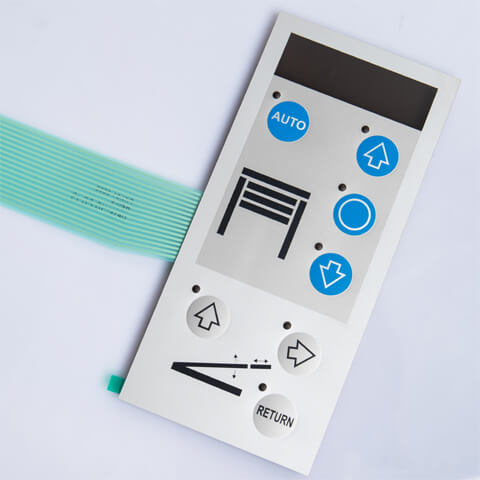Recognizing the Performance of Membrane Layer Switches Over for Individual User Interface Instruments
The capability of membrane changes stands for a considerable development in user interface layout, integrating efficiency with visual convenience. As sectors significantly focus on customer experience, recognizing the nuances of membrane button modern technology becomes crucial.
What Are Membrane Layer Buttons?
Membrane layer switches are innovative user interface tools that assist in individual interaction with digital tools. These flexible components contain several layers, including a graphic overlay, spacer, and a printed circuit layer. The style enables a smooth combination right into numerous digital devices, boosting both the visual and functional elements of interface.
Membrane switches are frequently used in a wide variety of applications, from house appliances to industrial equipment and medical tools. Their building and construction usually features a thin profile, making them a suitable option for portable styles. The responsive responses given by these switches can be engineered to satisfy specific individual choices, making sure effective communication in between the user and the tool.
Longevity is an additional substantial advantage of membrane layer buttons, as they are resistant to dust, moisture, and chemicals, which boosts their life expectancy in requiring atmospheres. Additionally, these switches can be customized in terms of shape, size, and graphic layout, enabling for branding and user-specific features. Overall, membrane switches stand for a practical remedy for enhancing individual experience in digital devices, incorporating performance with visual appeal in a reliable way.
How Membrane Changes Job
Operating on a straightforward principle, membrane layer switches over make use of a layered building and construction to register user input successfully. Each switch is composed of numerous layers, including a printed circuit layer, a spacer layer, and a top graphic layer, which are created to function with each other effortlessly. When a customer presses the leading layer, it presses the spacer layer, bringing the conductive aspects of the circuit layer into contact with each various other.
This call develops a closed circuit, indicating the tool to carry out a certain function. The layout enables numerous arrangements, including tactile comments, which can boost the user experience by giving a physical feeling upon activation. The products used in membrane layer buttons usually consist of adaptable substratums, such as polyester or polycarbonate, which make sure sturdiness and durability versus damage.

Secret Benefits of Membrane Buttons

An additional considerable benefit is their density. Membrane layer switches are thin and light-weight, which enables producers to save room in their tools without giving up functionality. This feature is specifically valuable in applications where weight and quantity are critical considerations.
Additionally, membrane layer buttons are immune to dirt, moisture, and chemicals, improving their durability. This strength extends their life-span and decreases the demand for frequent substitutes, leading to expense savings gradually.
In addition, the responsive feedback supplied by membrane layer switches can be optimized to enhance customer communication. They can include functions such as elevated buttons or audible clicks, improving usability and customer experience.
Applications Throughout Industries
Interface gadgets utilizing membrane layer switches prevail in a wide selection of sectors, showcasing their versatility and performance. Membrane Switch. In the medical field, membrane switches are important to gadgets such as analysis tools and client monitoring systems, where their sturdiness and convenience of cleansing are crucial for maintaining hygiene criteria. In the automobile market, these buttons are utilized in control panel controls and infotainment systems, offering a sleek and contemporary user interface for individuals.
Additionally, the consumer electronics industry gain from membrane switches in home appliances and handheld gadgets, where small layout and user-friendly interfaces boost individual experience. Industrial applications likewise take advantage of membrane layer changes for control panels in machinery and automation systems, highlighting their toughness and resistance to rough environments.
In the aerospace and defense markets, membrane layer switches are used in cockpit controls and equipment, where dependability and efficiency under extreme conditions are extremely important. Additionally, the video gaming market significantly integrates membrane switches in controllers and gallery makers, adding to an engaging individual experience. In general, the versatility of membrane switches allows their widespread use throughout numerous markets, highlighting their significance in contemporary interface layout.
Future Trends in Membrane Layer Switch Over Modern Technology

Additionally, using advanced materials, such as polycarbonate and polyester films, is expected to rise, offering enhanced toughness and resistance to ecological stressors. These materials add to the general durability of membrane layer switches, making them suitable for harsher commercial applications.
In addition, the incorporation of wise modern technology, including IoT connectivity, will enable membrane layer switches to communicate with other gadgets and systems, assisting in a more interactive customer experience. This pattern lines up with the growing demand for clever devices throughout different markets, from health care to customer electronic devices.
Lastly, personalization choices are anticipated to broaden, permitting makers to produce bespoke services tailored to details customer needs and preferences. These developments will certainly place membrane layer switches as essential elements in the development of interface technology.
Verdict
In conclusion, membrane changes stand for an essential improvement in customer interface technology, supplying a reliable and versatile service for varied electronic applications. As developments in product scientific research and touch sensing technologies continue, the functionality and applicability of membrane buttons are expected to broaden, reinforcing their importance in modern digital devices.